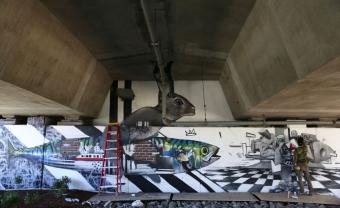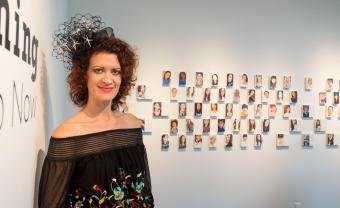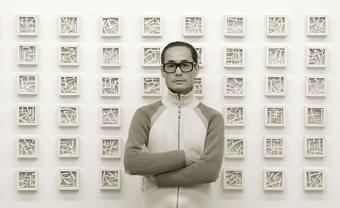In Aaron's work, nature is not just the subject: it's a participant. He says, "It's not that I necessarily believe that the forest, mountains, or water have an conscious self, but I love wondering 'What if?'" Aaron challenges the viewer to consider this question, whether they are an active participant, or a passive secondary or tertiary audience.
Participatory art is something Aaron has been interested in for some time, specifically because of the opportunity for empowerment that it provides the participants. He came to the College of Art and Design's MFA in Visual Arts program with an interest in nature and perception. This grew into something more refined as he was exposed to a broad range of contemporary art and structured research into participation and dialogue as an art form. Aaron credits his time at Lesley as a formative experience that helped develop his craft.
The Mani Project
Today Aaron's work continues to involve a research component with that same spirit of investigation of nature and human perception. Contemporary social and environmental issues are at the core of every project, as is the hope that the viewer gives new thought to the human relationship with nature.
A recent example is "The Mani Project," completed during Aaron's recent residency at the Shangyuan Art Museum in Beijing, China. The project features Mt. Kailash, in Tibet, a site considered to be the birth center of the universe in Buddhism, Hinduism, and other religions. Religious pilgrims make the holy voyage by foot, or even by repeatedly prostrating themselves - a ritual that can take months. It involves lying down, making a mark, and standing up and repeating the process all the way around the mountain. Over two millennia of pilgrims circling the mountain has resulted in a wearing away of the earth, creating the trail, but a paved road and plans for further development are altering the rich spiritual and cultural history of the area.
Aaron researched the kind of construction planned for the trail, which led him to the idea of steamrollers and their parallel with the prayer wheels that are a central part of Tibetan Buddhism. Aaron created a device, the Mani (meaning prayer) wheel, to mimic the prayer wheel. Inside the wheel were sheets of paper, pieces of metal, and sharp stones from the beginning of the trail - the marks made were a symbolic recording of the trail's final prayers before the trail is lost to progress. The sound of the metal as the wheel spun mirrored the sound of the bell on temple prayer wheels that ring with each revolution. Now, the spinning of the wheel, filled with the symbolic prayers, represents an offering of these prayers to the deities with each turn. Visitors to the Shangyuan Art Museum are invited to push the Mani wheel through the exhibition hall.
Around the outside of the wheel was a piece of drawing paper and graphite transfer paper. Each time the wheel hit a rock, a mark would be made - some very light and some more bold. These impact marks are not unlike the impact the trail has had on the millions of bodies as they have traveled around the mountain; or the impacts on the earth made by each of the pilgrims. The papers were changed each day of the trek. The trail's final "self portrait" was created by combining an overlay composite photograph of each of the three days drawings.
The Challenge of Documentation
In addition to the composite self-portrait of the trail, Aaron also offered documentation of the project through a video. Aaron emphasizes his desire to make sure viewers don't see the documentation as the work, but rather understand the collaboration between the trail and device as being the work. The device he created produced a product that viewers could see, but he also points to the importance of conveying that "the [Mani wheel] itself was a way of recording and disseminating the trail's prayers."
Aaron says that the challenge of separating documentation of the process of a project from the actual work itself is one he has been grappling with since his time at Lesley. People respond to the documentation and he understands that, but he says it is a constant concern and active priority to make this separation more apparent and accessible for a later audience.
Exploring new approaches to making this distinction is something Aaron will be considering as he works on an upcoming fall commission for a grant-funded exhibit curated by Fallen Fruit, a two-person social practice artist collaborative from Los Angeles. Aaron will be doing a project that continues with the idea of animating elements of nature. This time the main player will be the William River in Portland, Oregon. Aaron says he will try to challenge viewers in a playful way to engage with the project. The work will later be represented in a gallery space through creating an installation made of sound and light - no visual documentation from the river will be shown.
For more on Aaron's work visit aaronlish.com
Related Articles & Stories
Read more about our students, faculty & alumni.



